Wireless presentation with the Modena desktop app
With Modena Hub, every laptop, tablet, or mobile device can both share screens with the room display and receive content, resulting in more comfortable meetings. By eliminating impediments like HDMI cables, adaptors, or dongles, Modena Hub brings out the best in BYOD.
Modena Wireless Presentation from Biamp on Vimeo.
Modena App minimum requirements
Windows
- OS: Microsoft Windows 10, Microsoft .NET Framework 4.5, Microsoft Direct3D
- CPU: Intel i5 or faster
- Wi-Fi: For Presentation: 802.11n 2.4 GHz wireless network adapter, for Presentation + Wireless USB: 802.11ac 5 GHz wireless network adapter
MacOSX
- OS: MacOSX version 10.11 (El Capitan) or higher
- CPU: Intel i5 or faster
- Wi-Fi: For Presentation: 802.11n 2.4 GHz wireless network adapter, for Presentation + Wireless USB: 802.11ac 5 GHz wireless network adapter
Connect to the Modena device
Either the company LAN or Modena Hub+ embedded access point can be used for network connectivity.
LAN connection
In case of LAN connection, the task of installing and configuring the Modena unit to make it visible to all users on the LAN is the Network Administrator’s responsibility. Under this configuration, your personal device will be able to access Modena unit through the standard network configurations you already use to access your company LAN.
Embedded access point connection (Modena Hub+ only)
Modena Hub+ offers the possibility to directly connect to the unit, provided that you are in the range of its embedded WiFi access point and that it's been configured to allow such a connection. To do so, on your device select the WiFi name (SSID) of the Modena Hub+ you want to connect to. By default, the radio band in use is 5Ghz, the SSID is "modenahub" and the password is "modenahub", but they may have been changed (recommended!). Ask your Network Administrator for the Modena Hub+ credentials.
Windows and MacOS apps installation
Downloading the apps for Windows and Mac
You have two download options:
- From Biamp's website
- From your Modena unit. The apps and drivers for Mac and Windows devices can be downloaded directly from the Modena unit internal repository. Click on the three dots in the top right corner of the Modena home page and select the Apps entry.
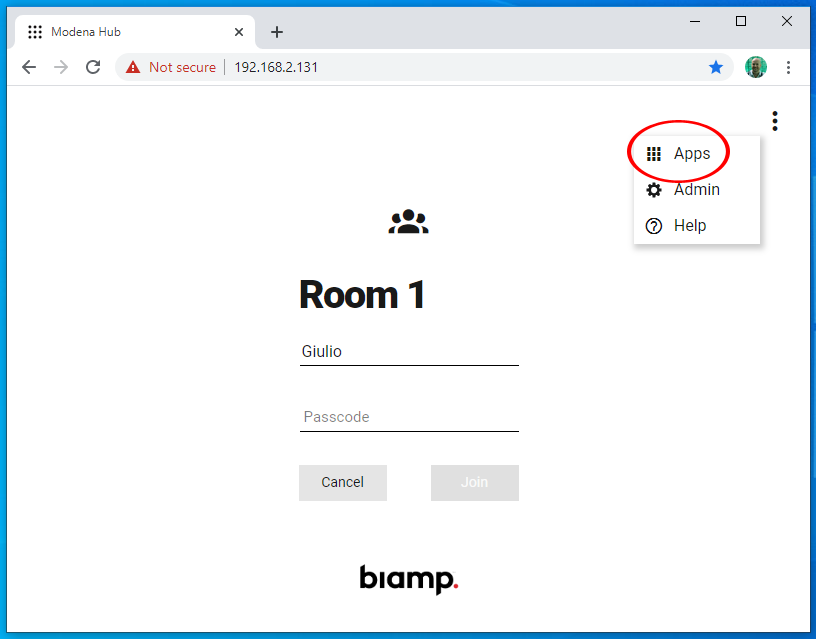
The download page appears:
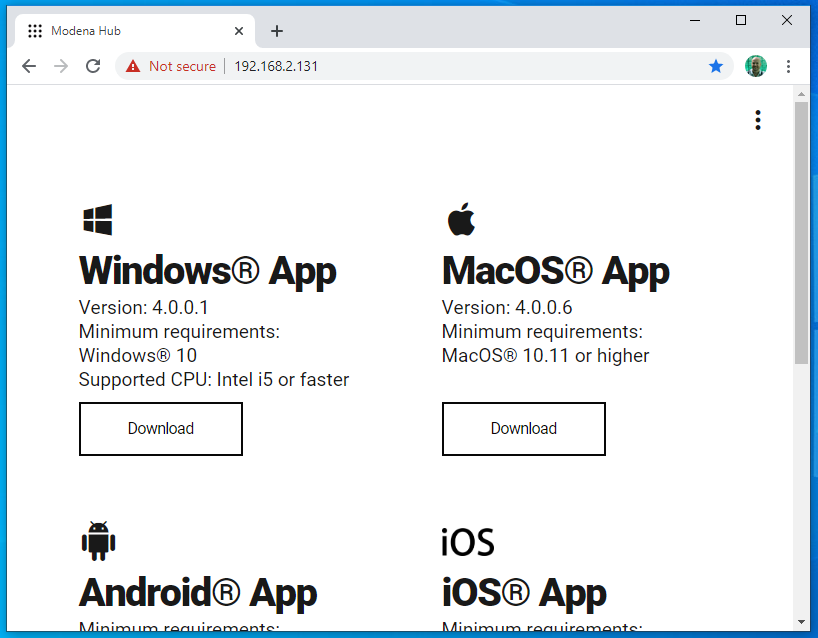
Click on the download button for downloading the Windows or MacOS app. These are installable clients and must be installed on the Mac or Windows computer.
Installing the apps for Windows and Mac
Before installing the client software, close all browsers and VC software. Launch the app set-up with a double click, the Modena app checks if a new version is available. In that case, it shows a link that you can click to download the updated version. When the download ends, a small window will prompt you asking if you want to update the installed app (if it was installed), install it (if not installed) or simply launch it. The Modena app can also be copied on a USB memory stick and launched from it. Unless you changed your default setup, the Modena app is configured to start at boot and should be ready for you to be used. If this is not the case, you can start it from the icon you can find in the apps repository. The actual appearance of the Modena app icon depends on your OS and on your screen settings, but it will be similar to the following:
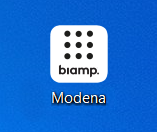
When active, you can find the Modena app in the Tray Area (Windows systems) or in the Status Menu (MacOS systems), identified by Modena's nine-dots icon.
The Modena drivers
The Modena virtual device drivers allow the computer, Mac or Windows, to believe that it has a USB microphone, speaker, and camera connected to the USB ports. Actually, they are virtual drivers, receiving the AV streams not from a physical USB connection, but from the network. This trick transforms the drivers into the interface between the Modena system and the UC/VC software.
The two driver packages
The Modena system can be used with proprietary apps or with the browser, a flexible client-less solution:
- The proprietary apps have embedded AV drivers that can be installed during the app setup, or later, from the app settings. These are the drivers used for the wireless USB feature when the app is in use.
- A stand-alone app drivers set is available when the user prefers to use the browser instead of the app.
Starting or joining a session
To start or join a session, you must have Modena App installed and running. Unless you changed your default setup, the Modena App is configured to be started at boot and should be ready for you to use. If this is not the case, you can start it from the icon you can find on your desktop or from your default applications folder, according to your installation preferences. The actual appearance of the Modena app icon depends on your OS and on your screen settings, but it will be similar to the following:

When running, you can find the Modena App in the Tray Area (Windows systems) or in the Status Menu (MacOS systems), identified by Modena system's nine-dots icon. Here is how it appears on different backgrounds:
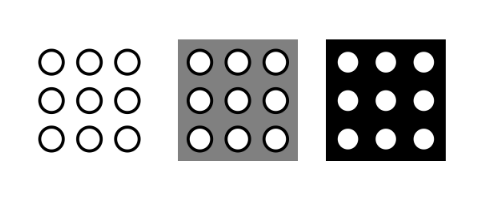
After clicking the Modena App icon, a Toolbar similar to the following appears:
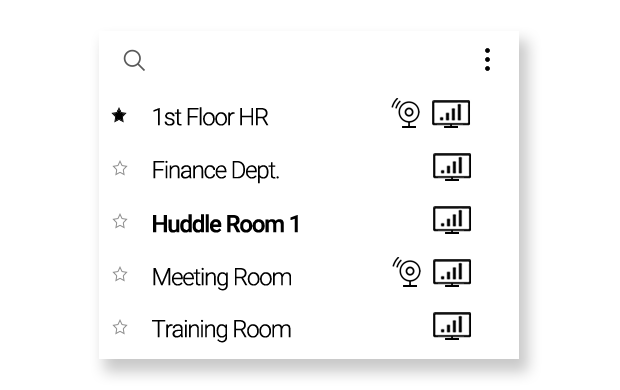
It lists the available rooms, together with icons that inform you about the availability of a display or a webcam. By clicking on the stars left of the room names, you can add or remove any room from your favorite list (favorite rooms show on top of the list). If you have a long list of rooms and you want to search one by its name, you can type next to the magnifier to filter the rooms by name. In the same area, you can also enter the IP address of the Modena unit you want to connect to: if the IP address is correct and the unit is reachable, you will get the corresponding room. You can now start a new session by simply clicking on any available room in the list. Rooms whose name appears in bold, have a session in progress, and if you click on them you join that session. When joining a passcode protected session started by someone else, a small window will ask you to enter the passcode. After you started/joined a session, the nine-dots icon in the tray area will turn blue.

Sending and receiving a presentation
When you start a session, the Toolbar changes like in the following image:
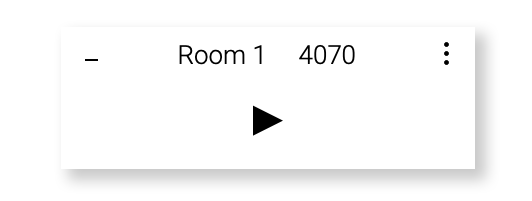
The passcode appears only if the room has been configured to be passcode protected. In this case, you have to tell the passcode to the other participants in order to allow them to join your same session. If some other participant is already presenting his/her screen, you can:
- become the presenter (replacing the current one)
- add your screen to the presentation
- receive the presentation on your device
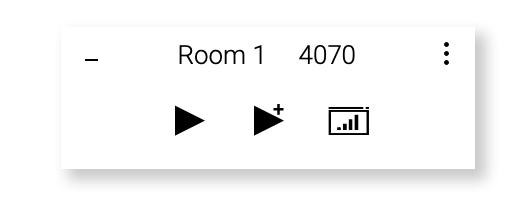
Presenting your screen
While you're presenting your screen, the nine-dots icon in the tray area turns red:

and the Toolbar changes again to offer you new options:
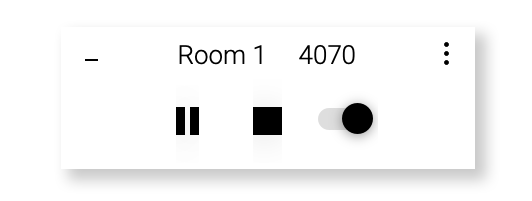
You can now:
- Pause the presentation: participants will see the last snapshot of your screen before you paused it
- Stop the presentation: you will not be sharing your screen anymore
- Lock the presentation: no other participant will be able to present his/her screen, until you unlock the presentation again
During a presentation, you will likely wish to hide the Toolbar by clicking on the button in its upper left corner. To get the Toolbar visible again, you have to click on the nine-dots icon in your tray area again. When a presentation has been paused, you can resume it anytime with just another click:
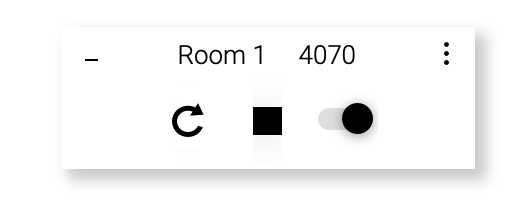
Receiving the presentation on your device
When you click the button to receive the presentation on your device, the Presentation window opens. Whether this window appears maximized or not depends on your settings. Inside the Presentation window you can:
- Press Esc if you want to restore the maximized presentation window to its previous size
- Close the window not to receive the presenter's screen anymore
- Right click to select which screen you want to receive, when a multi-presentation is in progress
- Right click to select the annotation layer, when an annotation session is in progress
Leaving a session
To leave the current session, click on the three-dots button to open the Menu, then select the Disconnect item.
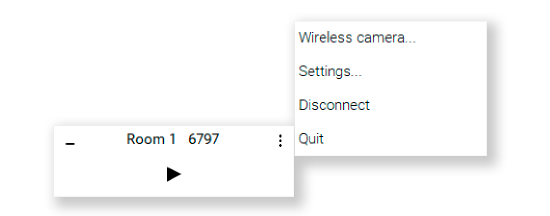
If you are the only remaining participant of the session, Modena automatically closes the session and makes the room available again for new sessions. When you leave a session, Modena App will not close itself, remaining available in your Tray Area.
App settings
Modena App default configuration works for most situations. However, you can customize its settings to make it suit your needs and preferences. Click on the three-dots button in the Toolbar to open the Menu, then select the Settings item.
The Settings window is organized in sections, which will be described below. Some of the parameters can be modified only when you're not connected to a room. At the bottom of the sections list you find two links:
- Support: opens Modena's support page in your browser
- Logs: prepares a log file to be sent to the support service for troubleshooting
Room
This section appears only when you are connected to a room, and shows the info about the room itself:
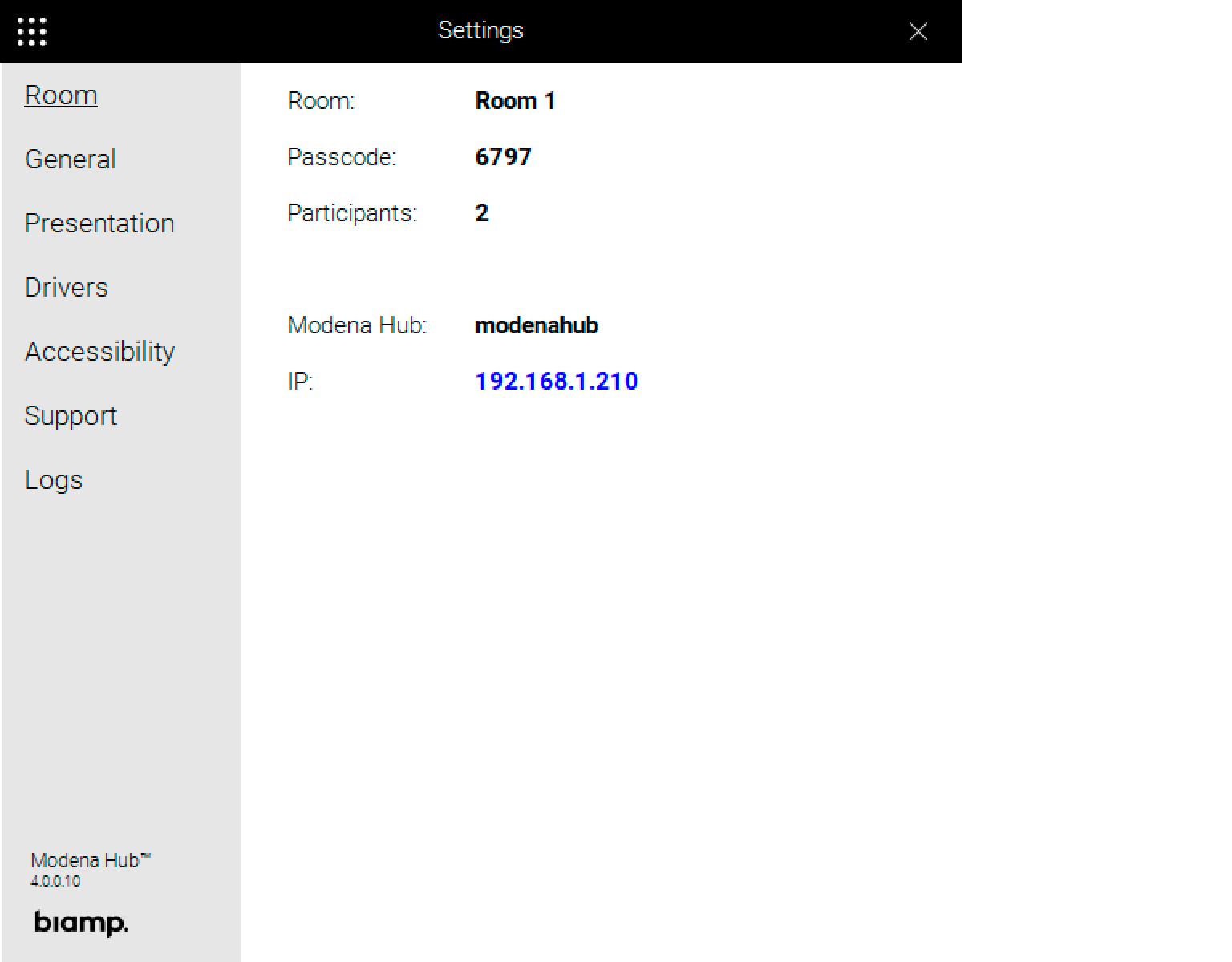
- Room: the name of the room you are connected to
- Passcode: the passcode of the current session, if any
- Participants: the number of participants connected to the current session
- Modena unit: the name of the Modena unit you are connected to
- IP: a clickable link to the IP address of the Modena device, that can be used to reach its administration page, or to be communicated to participants who want to connect with a web browser
General
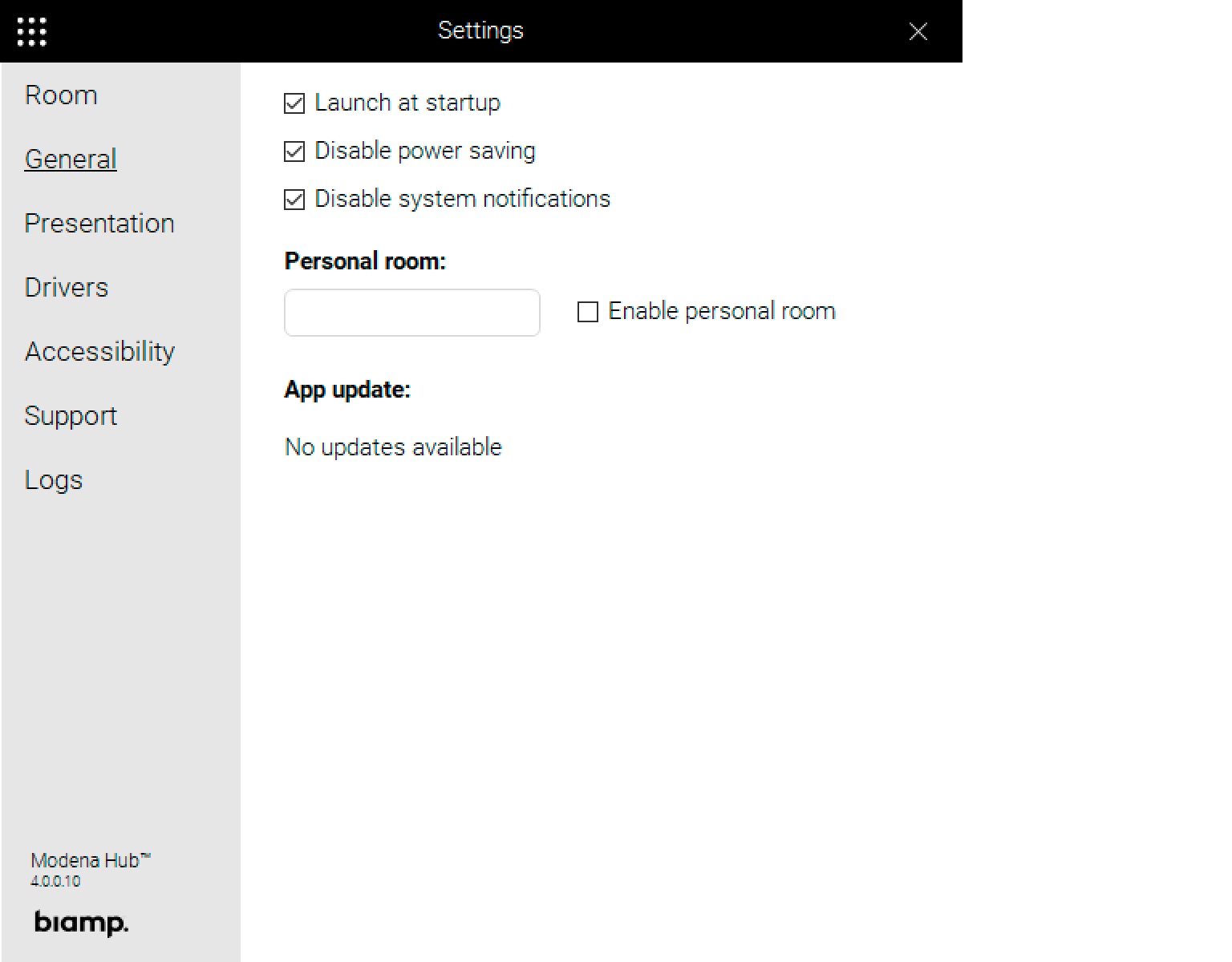
- Launch at startup: if checked, the Modena App will be automatically launched at every boot of your computer
- Disable power saving: if checked, automatic power saving standby will be disabled during sessions, because it causes WiFi disconnection (recommended)
- Disable system notifications: if checked, system notifications will be disabled during presentation, to prevent them to be visible to the other participants
- Personal room: a personal room is a room which, before a session is started, is visible only to the users who have its access code typed in this field. After a session is started, the room becomes visible to everyone, as a regular room. This approach allows to reserve rooms for some users
- App update: if a more recent version of the Modena App is available, this field shows a link where to download it
Presentation
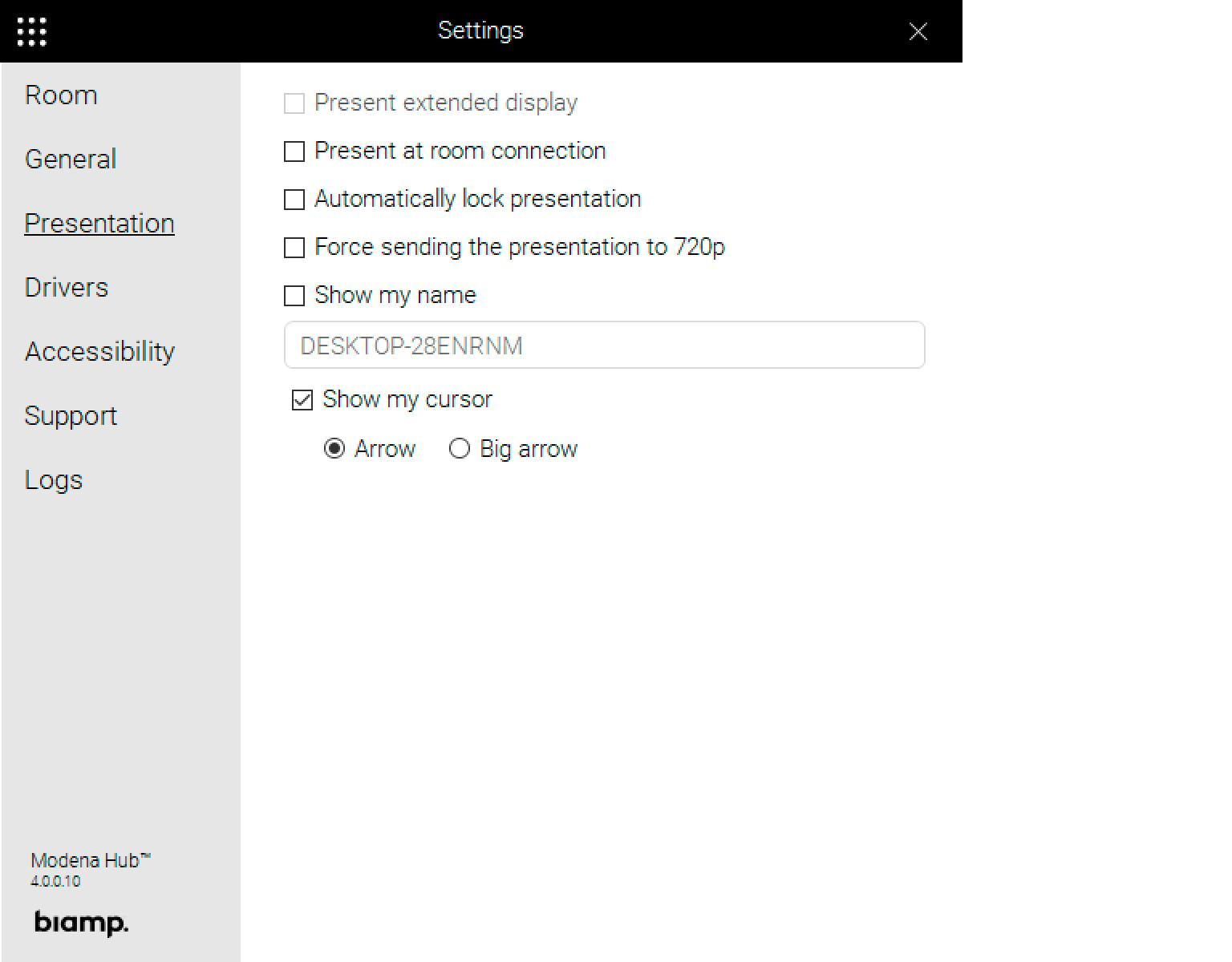
- Present extended display: when you are presenting from a PC that features multiple displays, you can enable this option to present the extended display
- Present at room connection: enabling this feature, the presentation starts automatically just after the connection to the room
- Automatically lock presentation: if enabled, when you start a presentation you will be automatically locked in, so as nobody else can take the presenter's role until you explicitly unlock it
- Force sending the presentation to 720p: by default, the presentations is sent with 1080p resolution. Under some network condition, you may prefer to reduce its quality to save bandwidth
- Force presentation at high frame rate (MacOS only): on Mac laptops, by default, the presentations is sent at 50fps for better performances. Under some network condition, you may prefer to reduce its quality to save bandwidth
- Show my name: if enabled, when presenting your screen, your name will appear at the bottom of the presentation. Type the name you want to show in the field below
- Show my cursor: if enabled, when presenting your screen, your mouse position will be shown on the devices receiving the presentation. You can make it appear like a regular or big arrow
Drivers
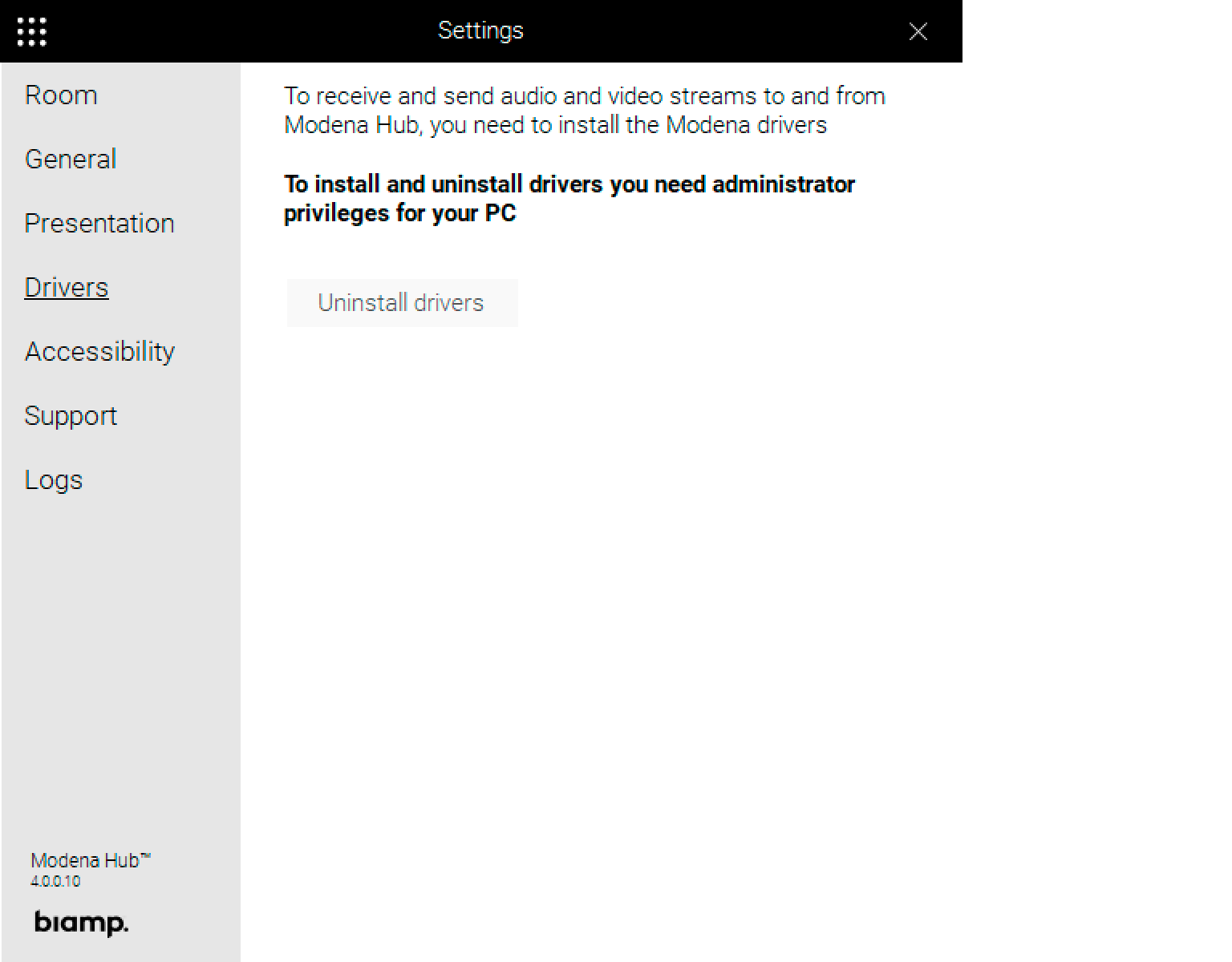
The Wireless Camera feature requires that you install the Modena drivers, to receive and send audio and video streams. The button in this page allows to install and uninstall the Modena App embedded drivers.
Accessibility
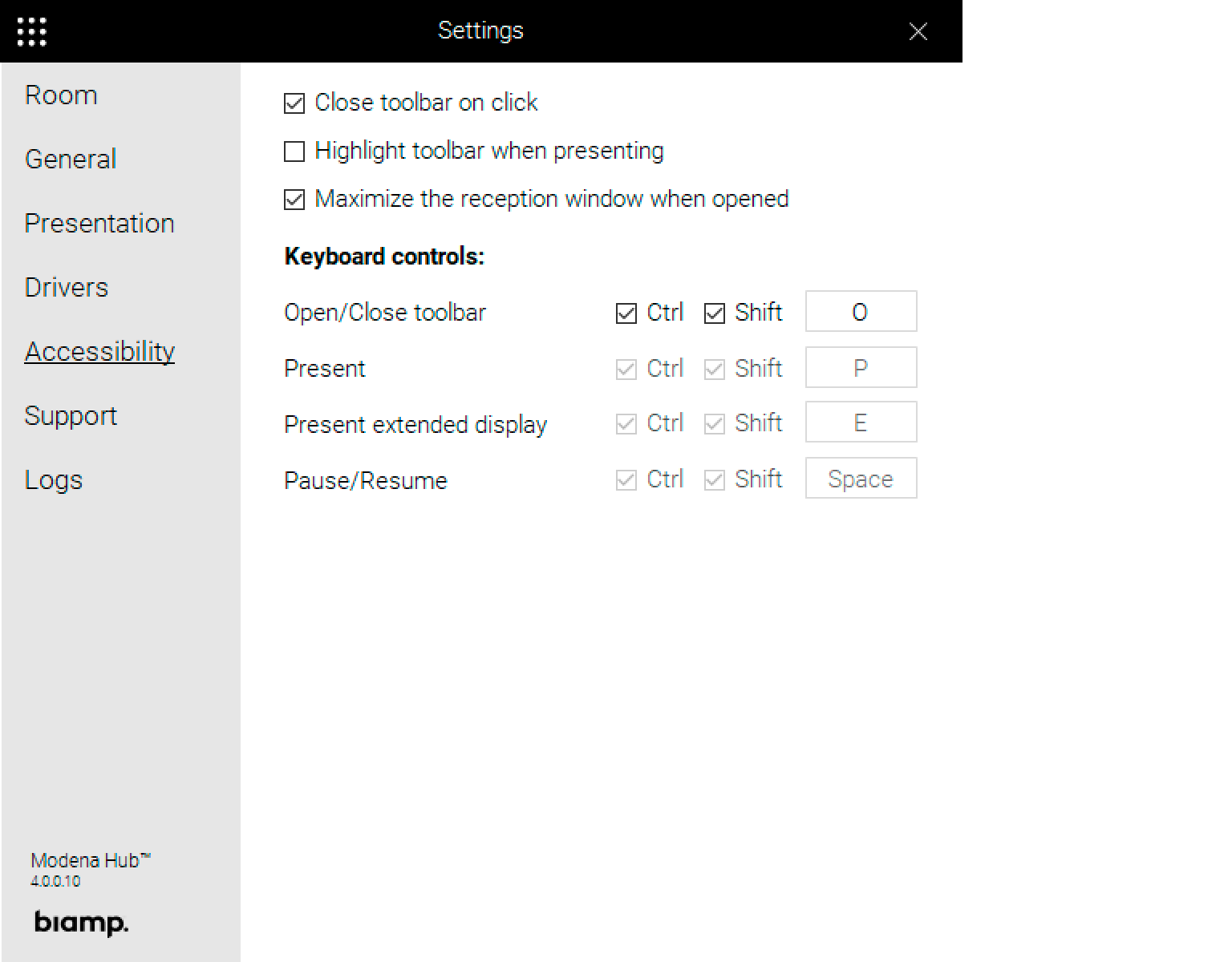
- Close toolbar on click: enable this option if you want the toolbar close automatically as soon as you click elsewhere
- Highlight toolbar when presenting: if enabled, this option surrounds your toolbar with a red frame
- Maximize the reception window when opened: if enabled, when you receive a presentation on your device, the presenter window opens in full screen mode
Keyboard controls: Select the keyboard shortcuts you want to associate to the most common tasks:
- Open/Close toolbar
- Present
- Present extended display (to present the content of your secondary monitor, if present)
- Pause/Resume
Presentation audio handling (Windows and MacOS only)
Requirements
- Modena audio drivers installed
- User connected to the Modena room (in session), either using the Modena app or the browser
- Modena Virtual Audio Device selected as system speaker on the computer
Audio output
The USB audio device connected to the Modena Hub is the default audio output device. In case of multiple USB devices connected to the Modena Hub, the web console configuration allows to select the active output device. In case no USB devices are connected to the Modena Hub, the default audio output is the HDMI port. On the web console configuration is possible to change the priority, selecting the HDMI output when USB audio devices are connected.
There's no audio output on the personal devices, Windows, MacOS, iOS or Android.
Audio output on Android TV
Android TV devices work like HDMI connected devices and receive audio.
WebRTC audio
When the browser is used to share the presentation to the room display, on some browsers is possible to tick an audio checkbox on the WebRTC sharing dialog, the dialog that asks what is the sharing source, desktop, application, or tab. Modena Hub uses has its own audio management and the user shall avoid to tick this checkbox.
Audio level
The audio level setting is on the web console configuration, on the webcam page.
Mobiles
iOS and Android involved in a Modena Hub session don't have audio capability.

